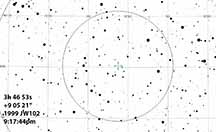
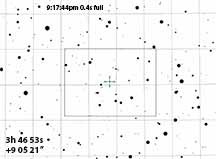
This is a difficult event, but with luck may be do-able, and give some confidence on the difficult Martschmidt event on Sunday. 8x would give 8/50 or 1/6s time resolution. and therefore 2 or 3 points at the occultation minimum. Might be detectable. If clean clear, maybe even 4x? Not likely though. Kirk may try from home. I will check clouds before driving to Natural Bridges. Any cirrus and I'll bail
 |
 |
Observed from the big palm tree near the end of Natural Bridges road. at 8x. Got a good recording. PyOTE found a 0.32s event within 1 sec of the predicted time. I used TME apertures on all stars, and a circular static aperture, as always, for "no-star". This made for a cleaner occultation with two deep points instead of more like 1.6 deep points at that time. I noticed that my stars were not focused perfectly and instead were tiny asymmetric "donuts" so that a TME aperture was probably better than the usual circular aperture, and that proved to be the case. I also noticed I got better results if I used the "median vertical and horizontal filter" as logic recommends for these Watec's. The folder containing this better analysis is just labelled "RN-PyM-1999JW102" and the first analysis with static 3.2px circular apertures and no median filtering, is labelled "RN-PyMnm-1999JW102" on the external HDD.
While this faint star is certainly at the limit of being doable for such a short event as we saw, the deepest two-point drop in light occured within 1 sec of prediction, and the false positive test gives it 3.8 sigma away from the point distribution w/o the drop, so it is very unlikely to be noise induced.
My location was deeper into the predicted shadow than Kirk Bender. However, his single point drop might in fact be real, pending a closer look.
magDrop report: percentDrop: 77.3 magDrop: 1.612 +/- 0.556 (0.95 ci)
DNR: 2.84
D time: [05:17:45.1731]
D: 0.6800 containment intervals: {+/- 0.0356} seconds
D: 0.9500 containment intervals: {+/- 0.0971} seconds
D: 0.9973 containment intervals: {+/- 0.2069} seconds
R time: [05:17:45.4931]
R: 0.6800 containment intervals: {+/- 0.0356} seconds
R: 0.9500 containment intervals: {+/- 0.0971} seconds
R: 0.9973 containment intervals: {+/- 0.2069} seconds
Duration (R - D): 0.3200 seconds
Duration: 0.6800 containment intervals: {+/- 0.0522} seconds
Duration: 0.9500 containment intervals: {+/- 0.1213} seconds
Duration: 0.9973 containment intervals: {+/- 0.2393} seconds
|
Full data recorded. |
Zoomed in. There were other single and one other 2-point drops, but none as significant as the one PyOTE identified, w/o any trimming of data. |
zoomed in further, showing the pair of deep drop points. |
Offset in distributions = 3.8 sigma, meets the minimum of 2 sigma |
If Kirk's single point dip is real, it is consistent with a slight north shift from the predicted shadow path above. |
1999 JW102, Feb. 21 from home, 8x. I didn't get a clear event though the noise. There is a single point drop near predicted time, but there are drops as deep or deeper scattered throughout. I tried different size apertures, but no distinct event. Predicted max was 0.4 sec, the detectability test said "An event of duration 0.300 seconds with magDrop: 2.5 is likely detectable."
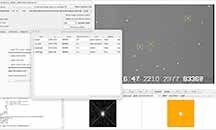 |
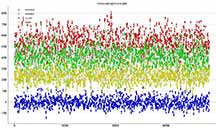 |
 |
 |
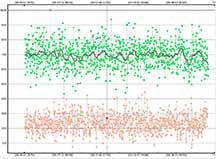 |
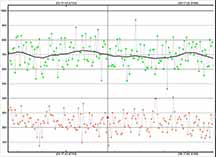 |